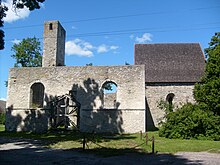Käina
Coordinates: 58 ° 50 ' N , 22 ° 47' E
Käina is a village ( Estonian alevik ) in the rural community Hiiumaa in Hiiu County ( Hiiu maakond ). It is located on the second largest Estonian island Hiiumaa (German Dagö ). Käina was the main town of the rural community of the same name until it was dissolved in 2017.
Description and history
Käina (German: Keinis ) has 690 inhabitants (as of December 31, 2011). The place is located on the bay of the same name ( Käina laht ), directly on the Baltic Sea . Käina is 19 kilometers south of the island's capital Kärdla ( Kertel )
Käina was first mentioned in a document in 1529 under the name Keinisz . Until 1939 the spelling of the place was officially Keina .
The episcopal estate of Käina was already an important place in the middle of the 16th century, especially due to the nearby harbor on the bay. The parish of Käina was established around 1500 . In 1627 the Reigi parish was divided.
After the island's capital Kärdla, Käina is the second economic and cultural center on the island of Hiiumaa. During the time of the Estonian SSR , important collective farms and industrial plants as well as a veterinary center were established there. Today, numerous Hiiumaa companies and companies have their headquarters in Käina. Nature and health tourism play a major role in the town. In 1959, healing mud from the Bay of Käina was first used for treatments. Today a modern indoor swimming pool is available to the population.
In the first half of the 19th century, Georg Friedrich Ignatius , who was pastor in Käina from 1818 until his death in 1865, founded the local parish school . The most famous educational institution today is the Käina grammar school. There is also an art school in the village. The Odra Iva village theater has its headquarters in the cultural center .
Martinskirche
The first wooden church was probably built in Käina as early as the 13th century. Today's stone church was built at the end of the 15th / beginning of the 16th century under Bishop Johann Orgies (Bishop 1492–1515). The first pastor in Käina is recorded for the year 1532. At that time the church was the largest on Hiiumaa with 600 seats.
The hall church in the Gothic style is kept simple and plain. In 1859/1860 the church was heavily redesigned and an extension was added.
The church was first dedicated to St. Nicholas , the patron saint of seafarers, and later to St. Martin .
The Evangelical Lutheran Martinskirche in Käina was destroyed by a German fire bomb on October 14, 1941 . Valuable art treasures were destroyed, such as the altars of the Virgin Mary, St. Nicholas and St. Antonius . The organ built by the father of the Estonian composer Rudolf Tobias was also destroyed by flames.
Today only the ruins of the church remain. A large park extends around the church.
literature
- Heinz von zur Mühlen (ed.): Baltic historical local dictionary. Part 1: Estonia (including Northern Livonia). Started by Hans Feldmann, edited by Gertrud Westermann. (= Sources and studies on Baltic history. Volume 8/1) Cologne / Vienna 1985, ISBN 3-412-07183-8 , p. 212.
Web links
- Description of the place (Estonian)
- Martin's Church in Käina
Individual evidence
- ↑ pub.stat.ee
- ↑ entsyklopeedia.ee ( Memento of the original dated August 13, 2016 in the Internet Archive ) Info: The archive link was inserted automatically and has not yet been checked. Please check the original and archive link according to the instructions and then remove this notice.
- ↑ puhkaeestis.ee
- ↑ Georg Friedrich Ignatius in the Estonian Wikipedia
- ↑ visitestonia.com




